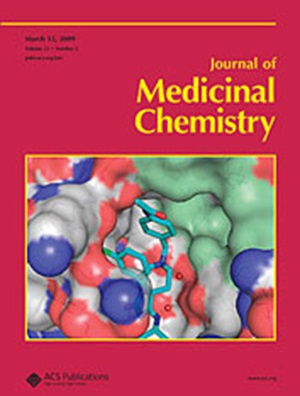Pyrazolo[1,5-a]pyrimidine-Based Type-I Photosensitizer as an Efficient Pyroptosis Inducer for Tumor Ablation
IF 6.8
1区 医学
Q1 CHEMISTRY, MEDICINAL
引用次数: 0
Abstract
Pyroptosis is a proinflammatory and lytic programmed cell death form, which can promote cytotoxic T lymphocyte (CTL) maturation and tumor infiltration through the release of damage-associated molecular patterns (DAMPs). Therefore, the induction of pyroptosis by small molecules is a promising strategy to activate antitumor immunity. In this work, we report the design of a new class of pyrazolo[1,5-a]pyrimidine-based type-I photosensitizers (PSs) as efficient pyroptosis inducers for cancer photodynamic therapy (PDT). Among the compounds, ZS-3 exhibited the most excellent reactive oxygen species (ROS) generation ability and phototoxicity in vitro. It was found that ZS-3 induced cell pyroptosis through the caspase-3/gasdermin E (GSDME) pathway under light irradiation, characterized by bubble formation and damage-associated molecular pattern release. Furthermore, ZS-3 lipid nanoparticles significantly inhibited tumor growth and evoked antitumor immune responses in vivo.

基于吡唑啉[1,5-a]嘧啶的i型光敏剂作为肿瘤消融的有效热凋亡诱导剂
焦亡是一种促炎和溶解性程序性细胞死亡形式,可通过释放损伤相关分子模式(DAMPs)促进细胞毒性T淋巴细胞(CTL)成熟和肿瘤浸润。因此,小分子诱导焦亡是一种很有前途的激活抗肿瘤免疫的策略。在这项工作中,我们报道了一类新的吡唑[1,5-a]嘧啶型光敏剂(ps)的设计,作为癌症光动力治疗(PDT)的有效焦亡诱导剂。其中ZS-3表现出最优异的活性氧生成能力和体外光毒性。发现ZS-3在光照下通过caspase-3/gasdermin E (GSDME)途径诱导细胞热亡,表现为气泡形成和损伤相关的分子模式释放。此外,ZS-3脂质纳米颗粒在体内可显著抑制肿瘤生长并引发抗肿瘤免疫反应。
本文章由计算机程序翻译,如有差异,请以英文原文为准。
求助全文
约1分钟内获得全文
求助全文
来源期刊

Journal of Medicinal Chemistry
医学-医药化学
CiteScore
4.00
自引率
11.00%
发文量
804
审稿时长
1.9 months
期刊介绍:
The Journal of Medicinal Chemistry is a prestigious biweekly peer-reviewed publication that focuses on the multifaceted field of medicinal chemistry. Since its inception in 1959 as the Journal of Medicinal and Pharmaceutical Chemistry, it has evolved to become a cornerstone in the dissemination of research findings related to the design, synthesis, and development of therapeutic agents.
The Journal of Medicinal Chemistry is recognized for its significant impact in the scientific community, as evidenced by its 2022 impact factor of 7.3. This metric reflects the journal's influence and the importance of its content in shaping the future of drug discovery and development. The journal serves as a vital resource for chemists, pharmacologists, and other researchers interested in the molecular mechanisms of drug action and the optimization of therapeutic compounds.
 求助内容:
求助内容: 应助结果提醒方式:
应助结果提醒方式:


